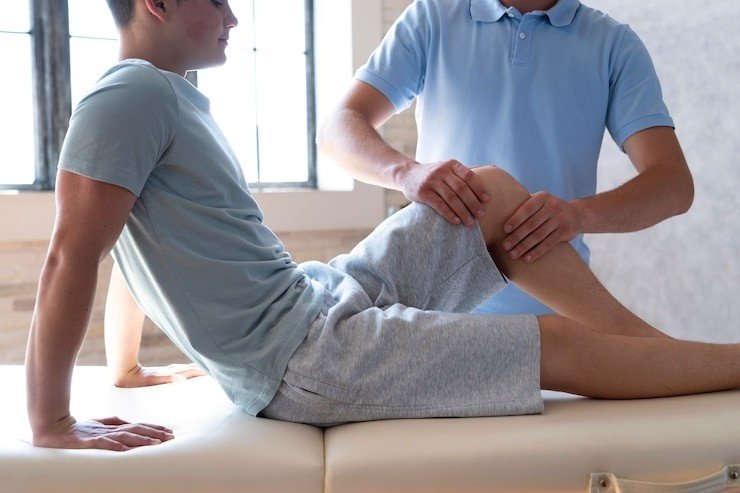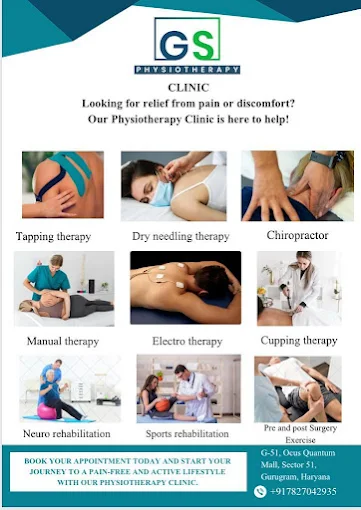
What Exercises Are Recommended by GS Physiotherapy to Reduce Sciatic Nerve Pain?
Sciatic nerve pain can disrupt your daily life—whether it’s a sharp shooting pain down your leg, tingling in your toes, or constant lower back discomfort. At GS Physiotherapy, we understand how challenging it can be to deal with this kind of pain, especially when it interferes with walking, sitting, or even sleeping. That’s why our expert team offers specialized physiotherapy for sciatic pain in Gurugram Sector-51 that focuses not just on temporary relief but on long-term recovery.
For more information, direct chat with us on WhatsApp
What Causes Sciatic Nerve Pain?
The sciatic nerve is the longest in the body. It runs from your lower back through your hips and buttocks and down each leg. Sciatic nerve pain, or sciatica, usually occurs when the nerve gets compressed or irritated due to:
A herniated or slipped disc
Spinal stenosis
Piriformis syndrome
Degenerative disc disease
Prolonged sitting or poor posture
At GS Physiotherapy, our team begins with a full assessment to determine the root cause of your sciatic pain before recommending any specific treatment or exercise plan.
Why Choose Physiotherapy for Sciatic Pain in Gurugram Sector-51?
Not all sciatic pain requires surgery. Most cases respond very well to conservative treatments like physiotherapy. At GS Physiotherapy, we use a blend of manual therapy, targeted exercises, and posture correction to offer comprehensive physiotherapy for sciatic pain in Gurugram Sector-51. Our approach is not only to relieve pain but to restore strength and mobility so you can get back to living a pain-free life.
Now, let’s explore some of the most effective exercises we recommend for sciatic pain relief.
Piriformis Stretch
Sciatic pain is frequently caused by the piriformis muscle, which is situated deep in the buttocks.
How to do it:
Lie on your back with both knees bent.
Cross the ankle of the affected leg over the opposite knee.
Gently pull the lower leg toward your chest until you feel a stretch in your buttocks.
Hold for 20–30 seconds, then switch legs.
Repeat 2–3 times per leg.
This stretch is a core component of physiotherapy for sciatic pain in Gurugram Sector-51 and is especially beneficial for patients with piriformis syndrome.
Cat-Cow Stretch (Spinal Mobilization)
The Cat-Cow Stretch is one of the most effective movements for promoting spinal mobility, improving posture, and releasing tension around the lower back—all of which contribute to easing pressure on the sciatic nerve. This simple, rhythmic motion alternates between two key yoga poses, helping to mobilize the spine and reduce stiffness that can aggravate sciatic symptoms.
How to do it:
Start by placing your knees behind your hips and your hands directly beneath your shoulders in a tabletop position.
As you inhale, lift your chest and tailbone toward the ceiling while allowing your belly to drop toward the floor. Gaze upward gently. This is the Cow Pose.
Exhale by pulling your chin to your chest, circling your spine like a furious cat, and using your hands to gently push the floor away. This is the Cat Pose.
Continue flowing between these two positions in coordination with your breath.
Perform this sequence slowly and mindfully for 1–2 minutes, or about 10–15 rounds.
At GS Physiotherapy, we often use the Cat-Cow Stretch as an entry-level spinal mobilization exercise, especially for patients beginning physiotherapy for sciatic pain in Gurugram Sector-51. What makes this movement especially effective is its ability to engage the full length of the spine in a low-impact way.
Sciatic Nerve Glide (Neural Mobilization)
Among the advanced techniques used at GS Physiotherapy, the sciatic nerve glide—also known as neural mobilization—is particularly effective for relieving pressure on the sciatic nerve without overstretching sensitive tissues. This gentle, controlled movement encourages the nerve to slide freely within its surrounding structures, which can help reduce inflammation, restore mobility, and alleviate pain caused by nerve entrapment.
How to Perform the Sciatic Nerve Glide:
Sit upright on a sturdy chair with your back straight and shoulders relaxed.
Extend one leg out in front of you until it's straight, with your heel resting on the ground.
Your toes should point upward toward your torso as you flex your foot.
At the same time, tuck your chin into your chest to softly drop your head.
Hold this position for a brief second, then return to the starting posture.
Repeat this controlled movement 10 times per leg, alternating as needed.
It’s important to move slowly and mindfully through each repetition. If you feel a sharp or shooting pain, stop immediately.
Important Note:
While this may seem like a simple seated exercise, the sciatic nerve glide is a specialized technique that should be performed under expert supervision. At GS Physiotherapy, our experienced physiotherapists are trained to assess your current condition and guide you through nerve gliding safely and effectively. Incorrect technique or overuse can irritate the nerve further, which is why we always incorporate this movement as part of a structured session of physiotherapy for sciatic pain in Gurugram Sector-51.
Standing Hamstring Stretch
Tight hamstrings can pull on the lower back and worsen sciatic symptoms. This stretch helps reduce that strain.
How to do it:
Stand with one leg elevated on a low bench or step.
Keep the elevated leg straight and your toes pointed upward.
Lean forward slightly while keeping your back straight.
Hold for 20–30 seconds, switch sides.
Repeat 2–3 times.
This simple yet effective stretch is a standard inclusion in our physiotherapy for sciatic pain in Gurugram Sector-51 plans.
Knee-to-Chest Stretch
This gentle stretch helps release tension in the lower back and gluteal muscles that may be pressing on the sciatic nerve.
How to do it:
Stretch your legs out while lying flat on your back.
Slowly bring one knee toward your chest, using your hands to gently pull it closer.
Hold for 20–30 seconds, then switch legs.
Repeat 3 times per side.
At GS Physiotherapy, we teach proper breathing techniques while performing this stretch to enhance muscle relaxation and healing.
Pelvic Tilts
Pelvic tilts strengthen your core and lower back muscles, improving spinal alignment and reducing nerve compression.
How to do it:
With your feet flat on the floor and your knees bent, lie on your back.
Tighten your abdominal muscles and gently flatten your lower back against the floor.
Hold for 5 seconds, then release.
Repeat 10–15 times.
At GS Physiotherapy, we often incorporate biofeedback or support tools to help patients perfect their form during pelvic exercises.
Bridge Exercise
This strengthening exercise builds the glutes and core, offering improved support for your spine.
How to do it:
With your feet flat and your knees bent, lie on your back.
Lift your hips toward the ceiling while pressing your feet onto the ground.
Squeeze your glutes at the top.
Hold for 5 seconds and slowly lower down.
Repeat 10–15 times.
Proper form is essential, and our therapists at GS Physiotherapy make sure you engage the right muscle groups to maximize results.
Lifestyle Tips to Enhance Exercise Benefits
In addition to guided exercises, we also recommend certain lifestyle changes that support your recovery:
Avoid prolonged sitting or standing.
Use ergonomic chairs or cushions.
Sleep on a firm mattress to support spinal alignment.
Stay active with low-impact movements like walking or swimming.
These simple changes, combined with consistent physiotherapy for sciatic pain in Gurugram Sector-51, can significantly speed up recovery and reduce recurrence.
Conclusion
Sciatic nerve pain doesn’t have to control your life. Through the right combination of stretching, strengthening, and guided movement, significant relief is not just possible—it’s achievable. The exercises listed above, when performed correctly and consistently, can make a big difference. If you’re struggling with sciatic pain and are searching for expert help, GS Physiotherapy offers trusted and results-driven physiotherapy for sciatic pain in Gurugram Sector-51.
For more information about GS Physiotherapy, visit https://gsphysiotherapy.in/ to learn more about their services or to book an appointment.



